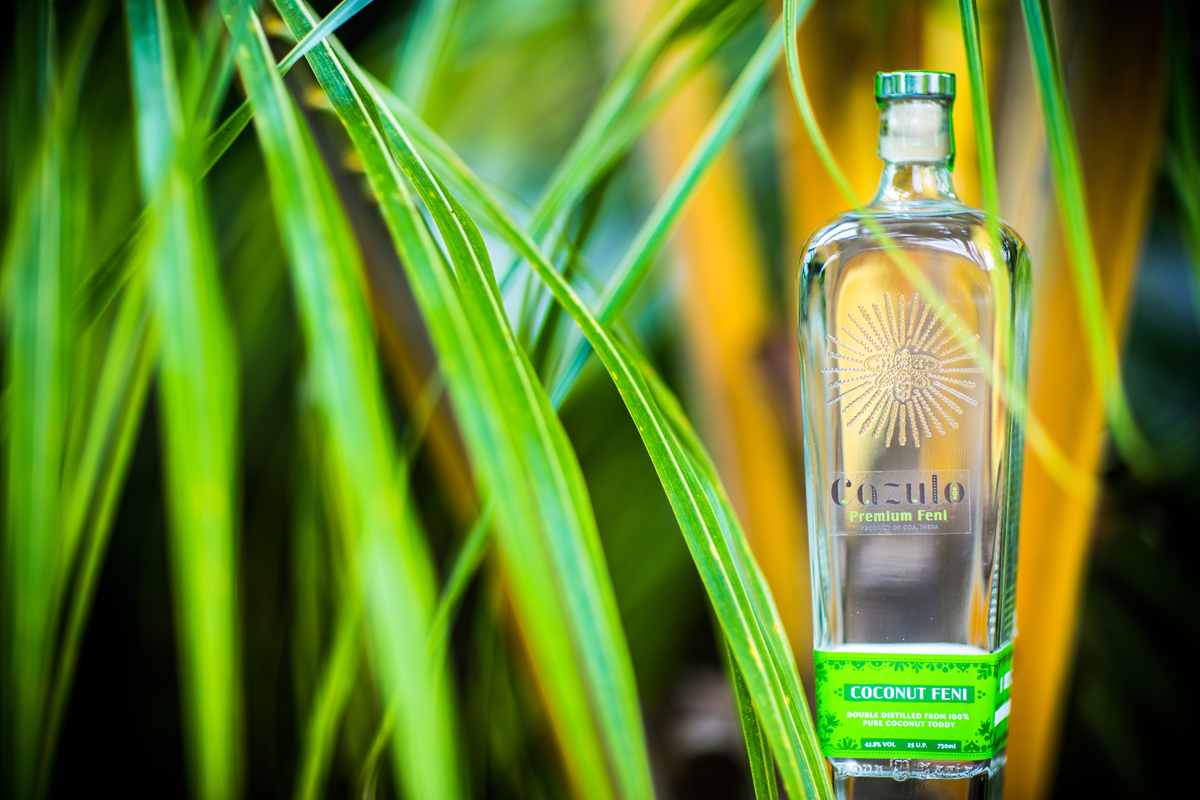Much like there’s very little sense in reading versions of Indian history written by European historians, it’s imperative Indians talk about their own heritage drinks. If Mexico has Mezcal, and Japan has Sake, India has Feni, the undisputed unofficial ambassador of the land and its people. Despite Feni having gone global, yet is still coaxing Indians, young and old, to drink and own it. Dawning the ‘Heritage Spirit’ tag like an albatross around its neck, it’s accessible to the world but not to Indians outside of Goa because of our convoluted laws. Things are changing though, and with that the image and acceptability of this fiery country liquor is steadily gaining favour.
On the onset I must confess, after being a trade professional for over a decade, I knew as little about Feni as you do today. At all my visits I looked for its two avatars – coconut and cashew – and brought them back sealed packed. Much like the King’s beer effect, which only tastes good at Goan shacks but not otherwise, Feni made for an unpopular choice at home soirees in Delhi. The resort, hence, was to make a punch with the locally produced coconut flavoured Cabo, pineapple juice, fruit slices, topped up with a limey soda, serve extra chilled. Feni made me feel like an outsider, an outcast, and the feeling was mutual. It was only this year when I returned to Goa and visited this charming Distillery in South Goa- Fazenda Cazulo, that I befriended the drink. All it needed was to be looked at from a different window, and Hansel Vaz, founder of Cazulo Premium Feni, provided just that. It also came at a time when Goa is deemed the epicentre for craft spirits production. And if at all there should be a quintessential first stop, it should be for Feni!
Coconut, Cashew and more
Though coconut and cashew are the most known expressions, astoundingly I found that a Feni could come in about 26 expressions, pure distillations, botanical expressions and even liqueurs- clearly carving out a niche for itself, not just as a drink, but a drink category by itself! While cashew Feni boasts a GI Tag, the cashew fruit itself was only introduced to India by the Portuguese in the 16th CE. What’s cool about this fruit from the Amazon rainforest, is that thrives on the red infertile hard rocky hills of Goa, and when Hansel says ‘Drink Feni and Save Goa’ he has a point! To distill more Feni Goa will need to plant millions of more cashew trees which in turn could save Goa’s pristine hills and keep Goa green forever for the future! Its interesting that the first mention of the distillation in Goa was in 1545, by a Dutch spy who described the process of Coconut Feni. Going back nearly 500 years now, no Indian drink has helped shape a civilization as much as Feni has.
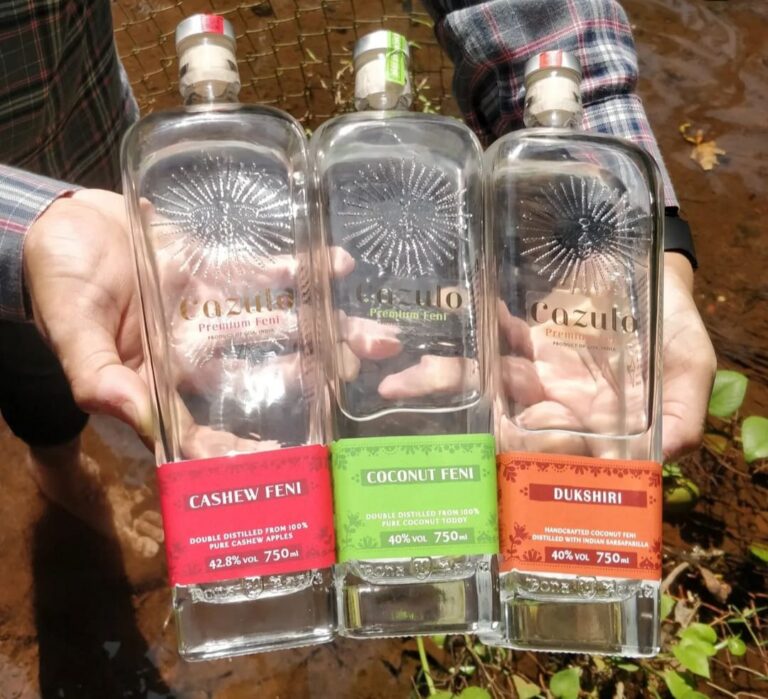
Feni – Matrimony
Feni culture stands unique in many ways. Firstly, it’s amongst the only six drinks in the world that are still fermented through a process called ‘underground natural fermentation’ in huge claypots called ‘Matheichi bhann’. The skill and craftmanship for making these claypots was so specialized that it even decided who and how the Potter married back then. Hansel shares that potters needed to be tall and slim, tall- for longer arms to make bigger and deeper pots- for batch consistency, and slim so that when they bend their paunch would’t leave a flat spot! To ensure the distilleries stayed loyal to the potter and his similar sized vessels, tall slim potters would look for equally shaped mates!! The shape of a pot decided your life partner, so much for a drink, eh!
Man over Machine
Secondly, while everyone gained from the Industrial revolution, Feni seem to have skipped it entirey. We barely heard any technical jargons on our visit, let alone spotting a scientific tool or equipment. Feni production relies on the best human gifts, their senses, intuition, and wisdom of age- all fine tuned over generations. At every stage from cashew juice to Feni, the distiller only looks and listens to gauge how far in the process are they. A quick fermentation of the cashew juice to 8% Cashew wine, followed by a rapid first distillation up 30%, and ended with a slow, low heat distillation upto 37-45% thrid distillate- without any discernable cuts for head, heart, tails of the cashew spirit. Feni is unique because, where most spirits are distilled to a higher strength and then brought down with distilled water, Feni is the only spirit that is distilled directly to ‘drinking strength’. Without a refractometer and hydrometer, how does one know at what strength? The answer lies in the etymology of the spirit’s name. Interestingly, “Feni” is derived from the Konkani word for bubbles- ‘fenn’. The distiller pours the spirit in a small glass and watches the size and shape of the bubbles which is indicative of its strength. Nope they don’t event taste it, so much so at Cazulo the distiller has a vow of refraining from drinking on the job. Interestingly this ‘bubble test’ is practiced in Mexico by Mezcal distillers as well!
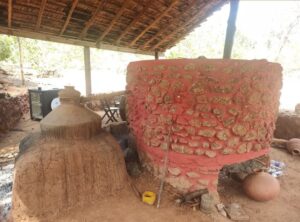
The laws around Feni
Even the way to govern the production of Feni is unique. Feni laws date back to around 1735, which are curiously still followed even today. One unique law is the Annual auction; Goa’s cashew orchards divided into ‘Zones’ are each auctioned twice, one for collecting fruits and then again for distillation. In Goa uniquely cashews can’t be plucked, to ensure perfect ripeness in fruit and flavour and thus can only be picked from the floor. While the first Auction allows the winning bidder only to use the cashew nuts, the second auction ensures the right to distill- only if he can buy the fruits from the first distiller! This practice lead to the entire community coming together and cooperating for a very sustainable economy, and self employing while value adding in creating the Feni economy- from the cashew fruit which ordinarily is considered an agricultural waste product. How wonderful!
Goa’s Feni laws are unique in its way of collecting ‘Duty’ for Feni production. Here, Excise Duty is paid on the number of Cashew or Coconut trees on the farm, and not on the volume of Feni they produce. Sounds confusing, but when I enquired Hansel about the rather unusual practice he said, “some smart bureaucrat figured that it is easier to hide or fudge production figures, than it is to hide a tree!”
Logical, I say! The first distillate of cashew fruit is called ‘Urraca’. It’s a tasty heady drink generally drunk with salt, lime, and a slit green chilli, topped with Limca. Interestingly the summer favorite and much loved Urraca is also deliberately not defined in Goa Excise laws, curiously because it thus cannot be branded or retailed, and only sold unlabelled. That came to me as a surprise, and yet again I turned to Hansel seeking a logical explanation. He smiled and said, “if it is defined you can sell it, and if you sold it, what will you have left to distill a Feni?”. The first distillate called Urraca is re-distilled into a Cashew Feni. Now I know he smiled at my foolishness, not my innocence.
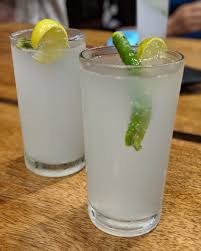
At Fazenda Cazulo- a centuries old feni distillery, guests are invited to understand the Feni-making process before sampling them. Much like any other spirit, Feni distillation puts a ton of sense in decoding the drink. Hansel is an amazing storytelling and translates traditional knowledge to modern audiences with ease. While cashew is produced only over three months and so limited in production; one may think because coconut Feni is produced all year round it would be affordable. The reality is far from it. Coconut Feni isn’t made from coconut water but from its flower’s bud nectar and only skilled toddy tappers collect it. This craft of Toddy tapping unfortunately is dwindling. Unless modernization can solve the problem of unavailability of coconut toddy, coconut feni will remain a pricier proposition, however, only in comparison.
The ‘Floating Feni’ Experience
Fazenda Cazulo’s signature Feni tasting expereince is the ‘Floating Feni’, where Feni’s are served and paired with a platter of colourful and interesting fruits, sweets, savouries items. Now being a sommelier I understand food and wine pairing and sort of knew what to expect. But bringing that view from the same window to this table was simply foolish. Feni doesn’t follow the European food pairings that say wines do. For that matter, the universal favourites like nuts, cheese, or citruses just do not agree with Cashew Feni on the palate. Who would’ve thought! Hansel again had our attention. They instead work with green chillies, bell pepper, green apple, guava, local delicacies like bimli, perad, tilia doce (sesame sweet), doce de grao (channa sweet), chorice pao, olives and more. Every time I thought I got a grip of the drink, it toppled me over. I needed an understanding of the drink the way I understand it best – in cocktails.
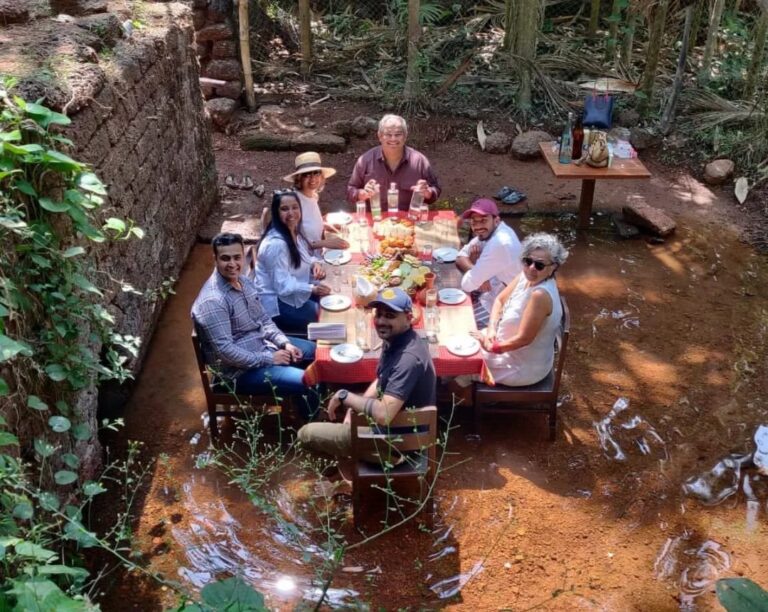
From ‘Bhann’ to the ‘Shaker Tin’
India’s best and Asia’s #4 bar is barely a few minutes drive from Cazulo’s distillery. Pankaj Balachandran and Arijit Bose, along Hansel’s younger brother Donovan Vaz, and Cazulo’s brand ambassador Karl Fernandes run Bar Tesouro. One easily notices that the first page of their menu is entirely dedicated to Feni cocktails- a bold step for any bar. Even a unique Feni called Dukshiri features on the menu, made from the roots of a rare plant- Indian Sarsaparilla . Now on tasting Feni the first time one may not agree with it, however Karl puts it in a simple way. He says “while eating a green chillies whole and by itself may not enjoyable, mixed in a curry and it adds personality and lifts it up. Similarly, you have to learn to use feni and a classic like a Negroni or a Margarita makes it more acceptable and enjoyable”. I was glad I received this gyaan on Day 1 of my week-long stay in Goa and all I did thereafter was to drink just that. So much so I craved from them once back in Delhi. I found a way to exploit all those bottles I had been stacking over the years.
What next?
As the demand and understanding of Feni grows, producers are also pushing for new paths. First on charts is making it available for sales outside of Goa. For that they need more supplies, that’re already available. Feni is already priced five times more in Canada than in India! Maharashtra government recently allowed using their cashew fruits for a Feni-styed spirit production, which may seem progressive, however doesn’t serve the Goan Feni distillers’ purpose. The vocal for local wave also couldn’t serve much for Feni given its limitation to the state because of its G.I. However, in this era when India is going through a cocktail revolution, Feni has gained much limelight. Places like Bar Tesouro, Joseph Bar, For The Record, Mahe, Jamming Goat, Bomras, all boast of Feni drinks which are reaching desperate travellers and they’re increasingly bringing the drink back home and flashing them under the craze of ‘homegrown’ spirits alongside crafty gins, rums, and whiskies from the state. The battle for Feni to become as cherished as say Indian gins is more political than anything else. Changing excise policies could be as daunting as changing the Constitution of India, which may need timely referendums, but there’s inherent reluctance towards them. A bit of hesitation also comes from the people of the land questioning if overproduction will lead to fiddling with their heritage. However a drink that has held its destiny in its own hands for 500 years barely has anything to worry about.
First published in Sommelier India Wine Magazine in November, 2022

